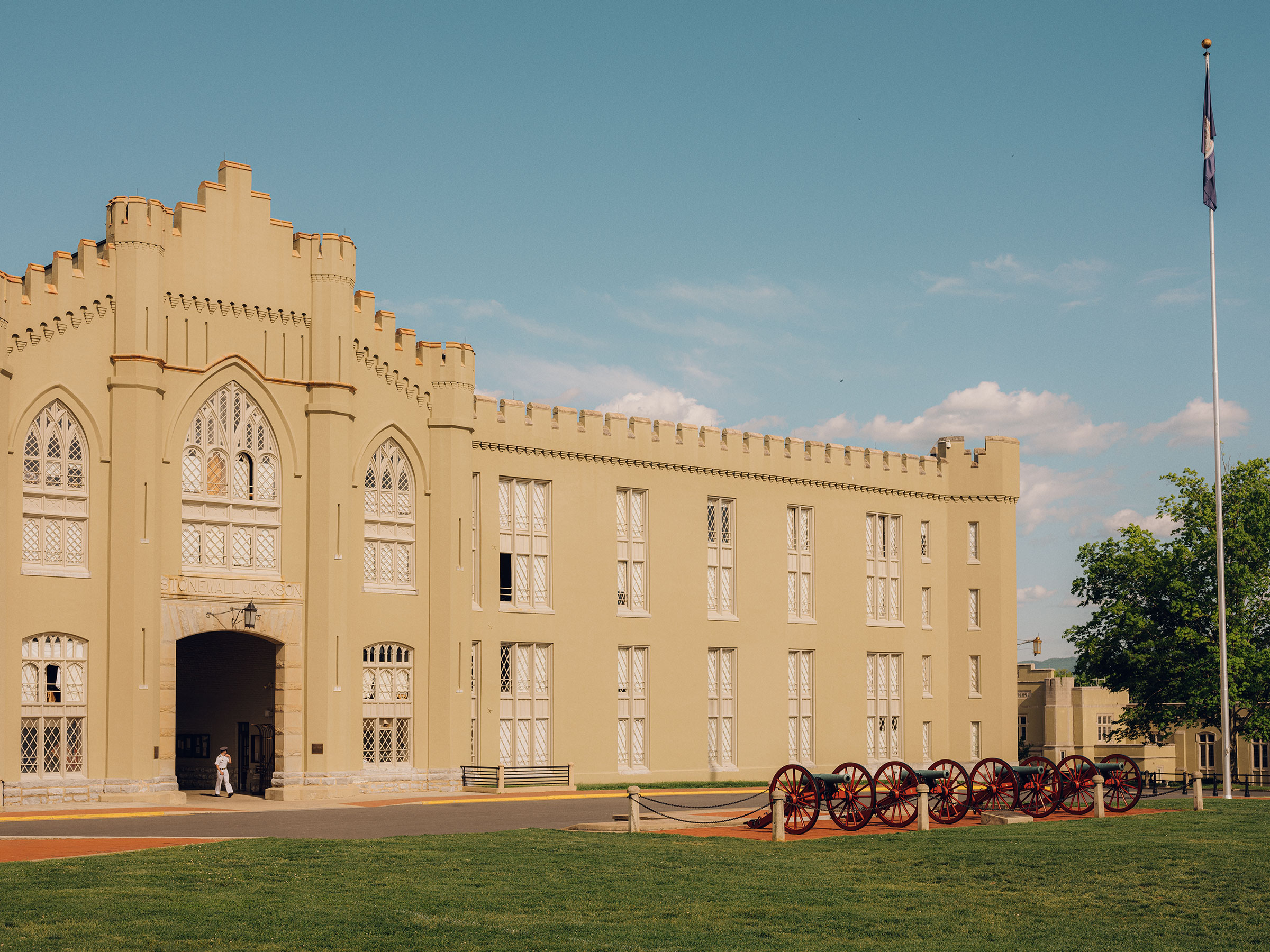It was a cold morning last December when they finally took Stonewall Jackson down. No ceremony was held, no protesters gathered; snowflakes swirled in the air. A crane silently hoisted the enormous bronze Confederate general from his perch of 108 years.
To many graduates of the Virginia Military Institute, that was no way to treat a hero. In a Facebook group for the “VMI Spirit,” alumni mourned the “erasing” of their cherished history. One called it “ethnic cleansing.” Several vowed to write the school out of their wills. “Shame on you low-life PsOS that were involved in this decision,” another man wrote. “May you be haunted nightly, by the Sons and Daughters of Virginia that fought and lost their lives in the War between the States.”
The statue’s removal ended a saga that divided the state-sponsored military academy in Lexington, Va., whose graduates include a recent Army secretary, the governor of Virginia, a Nobel Peace Prize winner, a civil rights hero and the late actor Fred Willard. For a small group of VMI alums who had been pushing for change at the 181-year-old school, it was a victory—but only a first step.
The four activists, men in their 40s, had all once considered themselves conservatives. A Marine officer, a corporate lawyer, a civil engineer and a former Fox News correspondent, they treasured their unorthodox college experience, from the intentionally dehumanizing freshman “ratline” to the nearly two centuries of military history. But the events of recent years had awakened them, like many Americans, to the injustice all around them, and they had come to see the school’s continuing veneration of its Confederate past as an embarrassing stain. In the aftermath of George Floyd’s murder, removing the statue, they believed, was necessary but not sufficient to root out the racism plaguing their alma mater.
Many of their fellow grads did not agree. The ensuing controversy toppled the school’s leadership and imperiled its funding. An independent investigation, ordered by the state, is probing the racial climate on campus after reports of racist behavior, from lynching threats to the disproportionate disciplining of Black students. And the institutional resistance the change agents faced radicalized them.
Their fight is a parable for our times. Recent years have seen a rapid, massive shift in America’s collective racial consciousness. At the height of last summer’s Black Lives Matter protests, one poll found the proportion of Americans who see racism as a “big problem” had surged to 76%, a 25-point increase in five years. It is the most profound shift in racial attitudes in a generation or more.
The change is likely just beginning. So is the backlash. Conservative politicians and right-wing media are decrying “cancel culture.” States are pursuing bans on “critical race theory” at public schools. Wokeness—a term that originated in the Black community and has become a touchstone for advocates and critics alike—is now the central axis of American political controversy.
Thrown by the cultural upheaval, institutions like the military, corporations and professional sports teams are trying to find their footing. What feels to liberals like an overdue breakthrough strikes conservatives as a sudden personal attack. And as our still contested history shows, fights like the one at VMI will reverberate into the decades to come.
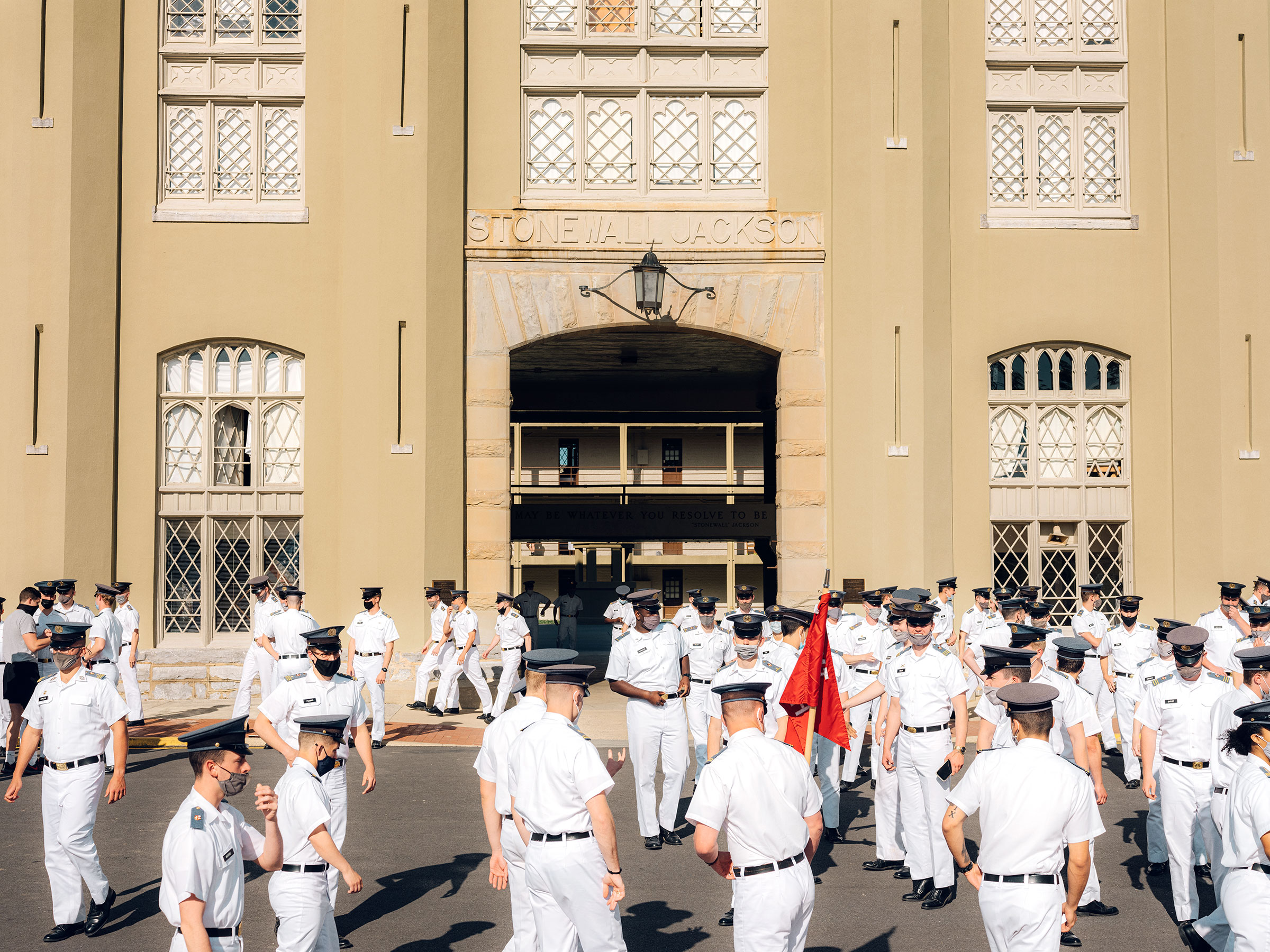
The Jackson statue occupied a central position in front of the hulking, Gothic barracks that house VMI’s 1,700 undergraduate “cadets.” The freshman “rats” were long required to salute it as they left the barracks through a stone arch bearing the general’s name. VMI says it dropped the saluting requirement in 2015, years before the statue came down. But this isn’t really true, I found: three recent graduates told me rats still had to salute in Jackson’s direction as recently as last year. The rulebook was merely changed to specify the salute be directed at the flag visible over the statue’s shoulder, something Black cadets had informally done for decades.
Today, no plaque marks the spot from which Jackson was yanked. All that remains is a flat patch of red bricks. Jackson, who is believed to have enslaved six people, taught physics at the institute for 10 years before joining the rebellion in 1861. He was not much of a professor, according to official histories: humorless and a poor communicator, he was the target of student pranks. In 1863, after leading the Confederate army in numerous major battles, Jackson died following a friendly-fire incident. He was buried less than a mile from VMI’s campus.
Founded in 1839 to guard the state arsenal, VMI sent thousands of students and graduates to fight for the Confederacy. In May 1864, 257 cadets, some as young as 15, marched 80 miles to the Battle of New Market, Va., in what is believed to be the only time in U.S. history a college’s student body has fought as a combat unit. Forty-five were wounded and 10 died.
Despite his undistinguished academic career, Jackson’s legacy has long pervaded the campus, known at VMI as “post.” Since the 1950s, a quote attributed to the general has been emblazoned on an interior archway as you enter VMI’s barracks: “You may be whatever you resolve to be.” The maxim, a favorite of Jackson’s, was apparently drawn from a reverend’s book of sayings the general carried. And Shah Rahman took the instruction to heart.
From the day he arrived at VMI in the fall of 1993, Rahman imbibed the institute’s mythology. His reasons for attending were unorthodox: as a child in Muammar Gaddafi’s Libya, where his parents had moved from their native Bangladesh, he acquired a taste for military symbolism, and fell in love with a serialization of Gone With the Wind on Libyan TV. He had little idea what awaited him on post. Then the ratline began.
The ratline: six months of nonstop verbal abuse, sleep deprivation and physical exertion, at the end of which cadets, all male until 1997, would “break out” by crawling through a mud pit. (In earlier eras, they fought their way out.) A combination of hazing, military training and indoctrination, the ratline aims to breakdown young cadets as individuals so they can be built back up as a unit. Rats are required to maintain a painful position known as “straining,” their chins on their throats. They can be singled out by upperclassmen and ordered to do push-ups or tasks. They recite the names of the slain New Market cadets and until recently re-enacted their charge on the battlefield. Attrition is high, but those who survive are bonded as “brother rats” forever.
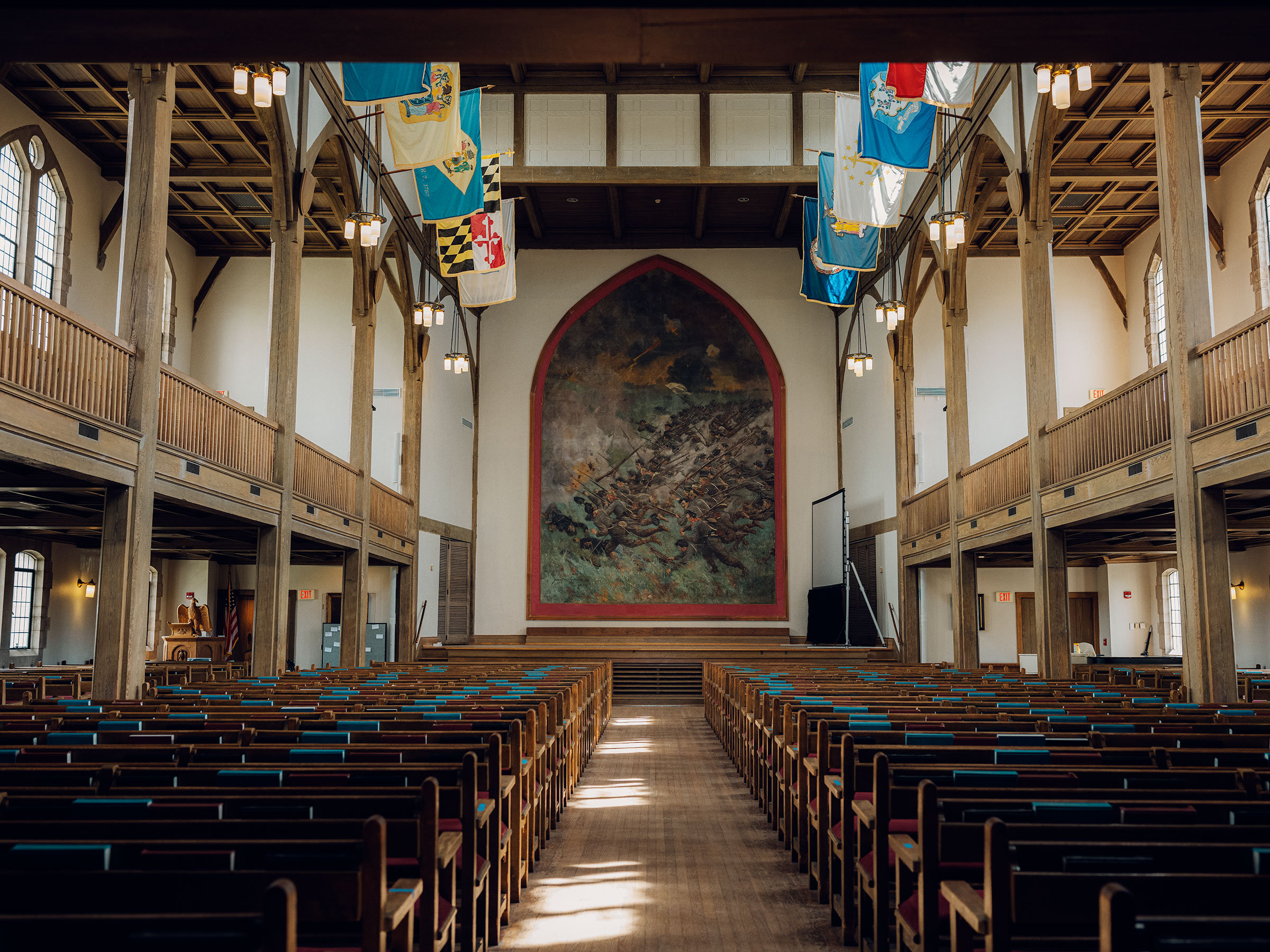
One day as Rahman hurried from the library to his room, a recent alumnus stopped him and told him to “get on your face.” Then the man, whom Rahman had never seen before, barked, “Stop, rat, get up. Why are you in my country?” He proceeded to berate Rahman, mocking his “Arab” ethnicity and Muslim faith. “My spirit was broken in that moment, realizing I’m being subjected to this for the color of my skin— punished for not being white,” Rahman told me, choking up. “Back in my room, I broke down and cried. Other than that, I don’t think I cried the entire time in ratline.”
The ratline is supposed to be a great equalizer. But that experience and others like it—some so humiliating he still cannot talk about them—made Rahman feel singled out and isolated. White cadets also seemed to feel no compunction about using the N word to deride Black Americans in his presence. “You heard it several times a day,” he says.
Rahman buried these experiences and redoubled his determination to succeed. As head cadet in the school’s museum, he led visitors on tours of the Confederate history it contained, including an exhibit on the VMI cadets who guarded the gallows at the 1859 hanging of the radical abolitionist John Brown—an execution overseen by the school’s founding superintendent, Francis Smith. When a Northern visitor insisted Brown was a hero, not a criminal, Rahman reacted with confusion and anger. Under his photo in the 1997 yearbook he had printed, “Inspired by Stonewall Jackson and General Patton, my boyish dreams came to life the day I matriculated at VMI.”
It would be two decades before Rahman questioned what he’d been taught. In August 2017, right-wing activists gathered at a Confederate statue in Charlottesville, an hour’s drive from VMI, to protest a push to remove it. Rahman’s first reaction was to wonder what kind of person would want to tear down a likeness of the great Robert E. Lee. “Then you quickly realize, Wait a minute, these people are a bunch of white supremacists,” he recalls. “I was so brainwashed I had never thought to question it. It never really occurred to me until that moment that these people we’d been taught to worship as heroes—they were scumbags and traitors, fighting their own country.”
Read More: Clashes Over a Show of White Nationalism in Charlottesville Turn Deadly
The following year, Rahman attended a VMI alumni fundraiser in Texas headlined by the school’s superintendent, J.H. Binford “Binnie” Peay III, a retired four-star Army general. In the wake of Charlottesville, protesters were calling for the removal of Confederate iconography across the country. Some of the alumni at the fundraiser asked Peay, who is white, what would happen to the statues at VMI.
As Rahman recalls it, Peay became agitated. His face went red, and he balled one hand into a fist. The statues, he vowed, would never come down on his watch. (Through a school spokesman, Peay declined to comment.)

Rahman was not the only one reconsidering things he’d learned at VMI. The Jackson statue survived the post-Charlottesville furor, but it wasn’t long before calls for change began anew. In June 2020, as protests over Floyd’s murder spread, a recent graduate named Kaleb Tucker posted a Change.org petition calling for the school “to acknowledge the racism and black prejudice that still occurs at VMI.” A good first step, wrote Tucker, who is Black, would be taking down the Jackson statue.
The petition drew hundreds of signatures, and stiff opposition. In a counter-petition titled “A Defense of the Stonewall Jackson Monument and VMI’s Sacred Heritage,” Jeremy Sanders, a white 2015 graduate, wrote that the school was “under attack” by “those who despise the very foundations of our beloved Institute.” Jackson, he wrote, “was not a perfect man, however he must be judged through the context of his age.” Yes, Jackson owned slaves, but he taught them to read and write, Sanders noted. He wondered where it would end: Should George Washington’s statue also be removed, or the New Market cadets’ graves dug up? Sanders urged the school to repudiate the “slanderous” claims of racism. His petition drew more signatures in a day than Tucker’s had in two weeks.
The school tried to show empathy. “I have struggled with ways to address you, this tragedy and senseless death of George Floyd in a meaningful way that is not just another lofty statement and one of platitudes,” Peay wrote in a June 2020 letter to the community. VMI had always sought to balance tradition with needed change, he wrote, pointing to the admission of Black men in 1968 and women in 1997 as positive steps for the school.
What Peay didn’t mention was that those evolutions weren’t exactly voluntary. By the time VMI began admitting Black students, it was the last public college in Virginia to do so, and the federal government had threatened to withdraw funding. The institute also fought against admitting women, battling the Justice Department for seven years, all the way to the Supreme Court. The school’s superintendent at the time, Josiah Bunting, called the 7-1 decision “a savage disappointment.” An attempt to evade the requirement by converting the school from a public to a private institution failed by a single vote of VMI’s board.
Donnie Hasseltine hoped this time might be different. A white Louisiana native and a classmate of Rahman’s, Hasseltine spent 22 years in the Marine Corps, retiring in 2019 to work in cybersecurity in the Bay Area. Seeing the petitions flying back and forth, he sought to find a reasonable middle ground. In an open letter posted online, Hasseltine argued that whatever the intent of VMI’s Confederate tributes, they now sent the wrong message. He suggested moving the Jackson statue and re-evaluating other monuments on post. “The question now,” he wrote, “is whether we prefer to have change dictated to us or to choose our own destiny.”

Two other alums on opposite coasts were thinking along similar lines. Mike Purdy, a Korean-American Navy veteran turned corporate lawyer in Northern Virginia, and Conor Powell, a journalist who had covered the war in Afghanistan for Fox News before settling in Los Angeles, were members of VMI’s class of 1999. For half their time at the institute, it was all-male, and like most cadets they were convinced the school would be ruined if it let in women. But when the change came, they saw the school work to make it successful. Within a few years, the controversy was forgotten; the institute not only survived with its fundamental values intact but also embraced its female graduates. In a June 2020 op-ed in the Richmond Times-Dispatch, Purdy and Powell called on VMI to “lead from the front” by removing the Jackson statue.
Purdy, I should disclose, is an old friend of mine and the reason I became interested in this story. When I first knew him, two decades ago, he was a conservative graduate student who delighted in needling campus liberals in policy debates. Over the years, I watched his politics gradually shift. Like many college-educated Republicans, he grew disenchanted with the GOP and finally broke with it over Donald Trump. Now he uses phrases like white privilege and systemic racism—and it baffles and frustrates him that so many seem unwilling to take the same journey.
“It’s been a slow evolution, but dealing with this VMI sh-t and Trumpism has turned me into a radical,” he told me recently. “How can you listen to this equality, colorblindness, heritage, ‘cancel culture’ bullsh-t anymore without realizing what’s really being said?”
Rahman and Hasseltine saw the op-ed, and reached out to Purdy and Powell. The four men strategized about how they might bring VMI’s decision makers to their point of view. Powell was optimistic: he had known Peay since childhood and attended VMI with Peay’s two sons. Powell knew the general as a good man, thoughtful and willing to listen.
“We write to you in the spirit of affection for the Institute, concern for its future, and a sincere desire to help VMI move forward in purposeful unity,” the foursome’s July 7 letter began. They proposed appointing a commission that would examine the campus’ Confederate symbols and recommend a way forward.
The overture was rejected. “Unlike many communities who are grappling with icons of the past, VMI has direct ties to many of the historical figures that are the subject of the current unrest,” Peay announced weeks later. “Stonewall Jackson was a professor at VMI, a West Point graduate who served in combat in the Mexican War, a military genius, a staunch Christian, and yes, a Confederate General.” The school would make changes to traditions like the New Market ceremony, he wrote, but would not remove any statues or rename any buildings.
This attitude struck the four men as shortsighted. “We tried to warn them: this fight is coming; there’s no way to avoid it,” Powell says. “They chose to ignore it.” The efforts at persuasion had hit a wall, but they did not give up. “What’s the first thing they teach you at VMI when you can’t get something to budge?” Purdy says. “Double down, toughen up, outlast them.”

As VMI clung to its past, the world around it had changed with disorienting speed. The Black Lives Matter movement took shape in the wake of the deaths of Trayvon Martin, in 2012, and Michael Brown, in 2014. The 2015 slaughter of nine Black churchgoers in Charleston prompted South Carolina to take down the Confederate flag that had long flown at its statehouse. President Trump’s racial provocation thrust long-ignored divisions into the center of the political discourse.
The result has been a major change in Americans’ racial attitudes, says Michael Tesler, a political scientist at UC Irvine. For two decades, from 1992 to 2012, polls registered little change on racial questions. But over the past decade, views on race have rapidly liberalized. For the first time, majorities believe that the police are more likely to brutalize Black Americans, that Black people face “a lot” of discrimination and that white people have an easier time getting ahead. Last year’s protests accelerated the shift. Starting in June 2020, the percentage of Americans viewing Black Lives Matter favorably spiked, while the percentage viewing law enforcement favorably plummeted.
Some observers have dubbed this sudden and unprecedented shift “the great awokening.” With the possible exception of the civil rights era, Tesler says, “there’s never been this monumental and swift a change” since the invention of modern opinion polling. The transformation can be seen in every population group, including conservatives and people of color. But it is mostly being driven by white progressives, whose views on some racial questions are now more liberal than those of Black people.
The rapid shift has created tensions, including at VMI. Black cadets have reported a slew of disturbing incidents in recent years, including students wearing blackface and using the N word. In 2017, a group of white cadets dressed up as “Trump’s Wall” for Halloween, with “graffiti” reading KEEP OUT and a slur for Latinos. The “wall” won the school costume contest, and the commandant of cadets, William Wanovich, posed for a grinning photo with it.
Read More: America’s Long Overdue Awakening to Systemic Racism
“Once Trump got into office, VMI became a different place,” says Keniya Lee, a 2019 graduate who is Black. “People felt like they could do things, say things, tell certain people they don’t belong.” When a white business professor reminisced fondly about her ancestors in the Ku Klux Klan, Lee filed a complaint. The professor apologized, but said she believed Lee was being overly sensitive. Lee says she is still traumatized by her experience at VMI.
Some of the institute’s most prominent and dedicated Black alumni told me they weren’t shocked to hear racism exists at VMI today. What shocked them was that it was apparently tolerated. Refusing to ignore misconduct is a central part of the VMI creed. The school’s honor code is cherished for its blunt simplicity: “A cadet will not lie, cheat, or steal, nor tolerate those that do.” A single violation results in expulsion, enforced by a cadet-run Honor Court.
Even in the early days of the school’s racial integration, “we had leaders that never allowed things to get out of hand,” says Glen Jones, a Black 1978 graduate who went on to serve on the VMI board and who has been heavily involved in the alumni community. “Were there racist acts, being called the N word, did those things happen? Yes, they did, just like they do in society. But what you had was oversight.” In talking to younger Black cadets, Jones says, he was saddened to find many don’t think that’s the case today.
Gene Williams, class of 1974, told me that as a cadet, he felt safer on VMI’s campus than he did off it. Yes, there were insults; yes, veneration of the Confederacy was everywhere. But he always felt equal to his white brother rats. Williams has devoted much of his adult life to the institute, serving 10 years on the board and establishing a campus summer program for at-risk youth. “At one point in time, it’s clear VMI was systematically racist,” he says—foreign students were admitted decades before Black Americans. Today, he doesn’t believe there is systemic racism, but he believes the school’s leaders were blinded by their unwillingness to think outside their own experience.
Last June, Williams wrote a long private letter to his friend Peay. The time had come, he wrote, “to be bold and not tinker at the margins.” Taking pains to explain that his suggestions were offered in a constructive spirit by someone with a deep love for the institution, he proposed several concrete steps, including greater diversity in hiring, mandatory bias training, and “to make racism and sexism as unacceptable as dishonor.” A reckoning was needed, he argued. “It is challenging even writing some of these words,” he wrote, “and I know that it will be exponentially more difficult for many folks to read and even consider them.”
Peay dismissed most of Williams’ suggestions, and went on to issue his defiant letter insisting the Confederate statues would be kept. “Nobody can say they weren’t told the perspective of people of color,” Williams told me. “I respect and admire General Peay, but he’s an 80-year-old white man. They just didn’t go far enough, not because they’re not good people, but because of a lack of perspective.”
It was disillusioning for alumni like Williams and Jones. For decades, they had felt a deep bond with their brother rats. But when it mattered most, their brothers refused to believe their testimony.
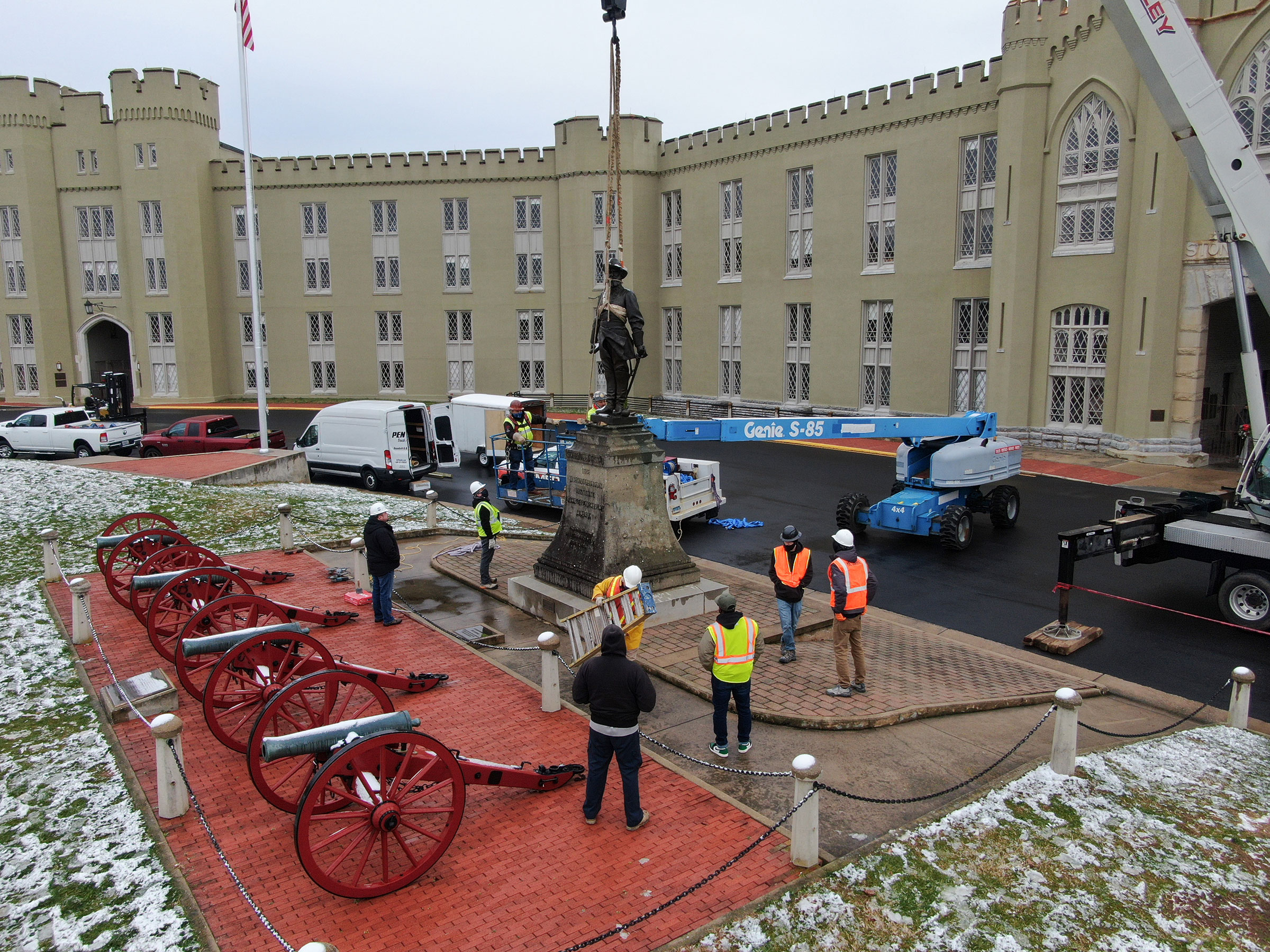
Like Williams, the foursome of 1990s graduates—Hasseltine, Powell, Purdy and Rahman—had tried persuasion and failed. Next they went public.
Rahman got a Washington Post reporter, Ian Shapira, interested in the story. He urged Shapira to look beyond the hot-button issue of Confederate statues to the broader racial climate on post. On Oct. 17, a month after VMI’s board voted to approve Peay’s blueprint and keep the Jackson statue, Shapira’s article detailing “relentless racism” at VMI appeared on the Post’s front page. It recounted a litany of troubling events, including a 2018 incident in which a white upperclassman threatened a Black freshman with lynching. The upperclassman was suspended rather than expelled; the freshman was later expelled for cheating, a charge he contended was concocted as retaliation. The article also detailed the steady stream of racial slurs cadets post on Jodel, an anonymous chat app.
Reaction was immediate. Democratic Governor Ralph Northam, VMI class of 1981, ordered an independent investigation into “the clear and appalling culture of ongoing structural racism” at VMI. The Democrat atop the state senate budget committee threatened to yank its $19 million in state funding if nothing changed.
Bill Boland, the president of VMI’s board of visitors, issued a statement insisting “systemic racism does not exist here.” The incidents described, he said, were isolated events that had been addressed. But within a week, Peay, who had been planning to retire at the end of the year, concluded the governor had lost confidence in him and resigned. A few days later, the board, fearing a broader crackdown, voted unanimously to remove the Jackson statue and set up committees to examine the school’s racial climate and Confederate monuments. Two members resigned in protest before the meeting.
To many alumni, it all smacked of “cancel culture.” A liberal mob, abetted by the news media, had manufactured phony grievances to force the school to succumb to the faddish tide of political correctness. It seemed especially rich coming from Northam, who in 2019 was discovered to have published a blackface photo in his 1984 medical-school yearbook. (He later denied he was in the photo and resisted calls to resign.) Peay, many argued, deserved the same due process Northam had demanded. “But instead of a fair inquiry, what you delivered was an accusatory, full-on cultural and political vendetta against your alma mater,” wrote a 1967 alum and former board member, Carter Melton, in an open letter to the governor he paid to have printed in the Times-Dispatch as a full-page ad. (A spokeswoman for Northam said the governor was “concerned by the pace of progress,” and noted that his letter was hardly the first time VMI had been called upon to change.)
The Republican state senate leader, Tommy Norment, a 1968 VMI grad, warned Northam not to “let the media lynch VMI.” Purdy and his allies were threatened and called “quislings” and “traitors” on Facebook. White alums posted that the Civil War had nothing to do with slavery and that Stonewall Jackson was a hero. VMI’s Black students, many commenters argued, were mostly athletic recruits who benefited from lower academic standards and didn’t appreciate what made the school special. “Remove the black alumni, problem solved,” one wrote.
There was no winning the argument for the minority cadets who sometimes spoke up to challenge these views. If they testified to their personal experiences, they were branded as “disgruntled” complainers; if they didn’t, they were held up as proof that racism wasn’t really prevalent. The controversy shattered the bond of rat brotherhood. The Peays, whom Powell once considered as close as family, no longer speak to him. In one online exchange, a classmate challenged Hasseltine’s honor, a VMI taboo. Rahman says he would not feel safe setting foot on campus. “Donnie and I thought, our brother rats, they will never turn their backs on us,” Rahman says. “That was not the case. I have never been so disappointed.”
One group of conservative alumni has formed an unaffiliated political action committee, the Spirit of VMI, that plans to grade elected officials and run political ads. In a recent webinar for supporters, the group’s leader, a 1985 graduate named Matt Daniel, explained its raison d’être: “We were heartbreakingly disappointed that an entire community, a family, people that we know and love and respect, were all labeled as racists—not just incidental racists but systemic racists,” he said. (Daniel declined to be interviewed unless I agreed to answer a series of questions and commit to running his responses to my questions verbatim. Other alumni who have publicly opposed the changes under way at VMI also declined interview requests.)
Rather than fight, some turned defeatist. “If the wokes intend to knuckle VMI under, perhaps there is a greater question at stake here: is VMI worth saving?” a former state GOP executive director named Shaun Kenney wrote in a blog post titled “Maybe VMI Needs to Close on Our Terms.” The alternative, conservatives fret, is a campus whose distinctive features have all been erased, smoothed into another snowflake-coddling bastion of censorious academic liberalism, where students spew social-justice jargon, invent new pronouns and accuse one another of “problematic” behavior.
They are right about one thing: the liberals have already won, and there is no going back. Stonewall Jackson’s bronze body sits in storage at New Market, waiting to be resurrected in his new home overlooking the battlefield. In April, the school replaced Peay with its first Black superintendent, Cedric Wins, class of 1985. A search is under way for VMI’s first chief diversity officer. At a public meeting in December, the board received a presentation from the state’s chief diversity officer, Janice Underwood, who laid out the difference between “equality” and “equity” and explained why statements like “I don’t see color” are not acceptable. Underwood urged the board members to “lean into discomfort” and suggested they pick up Robin DiAngelo’s book White Fragility.
It has come to pass as Purdy and his allies predicted. The institute rejected the opportunity to change on its own terms; now it is at the mercy of liberal outsiders, dragged kicking and screaming toward what they consider progress.
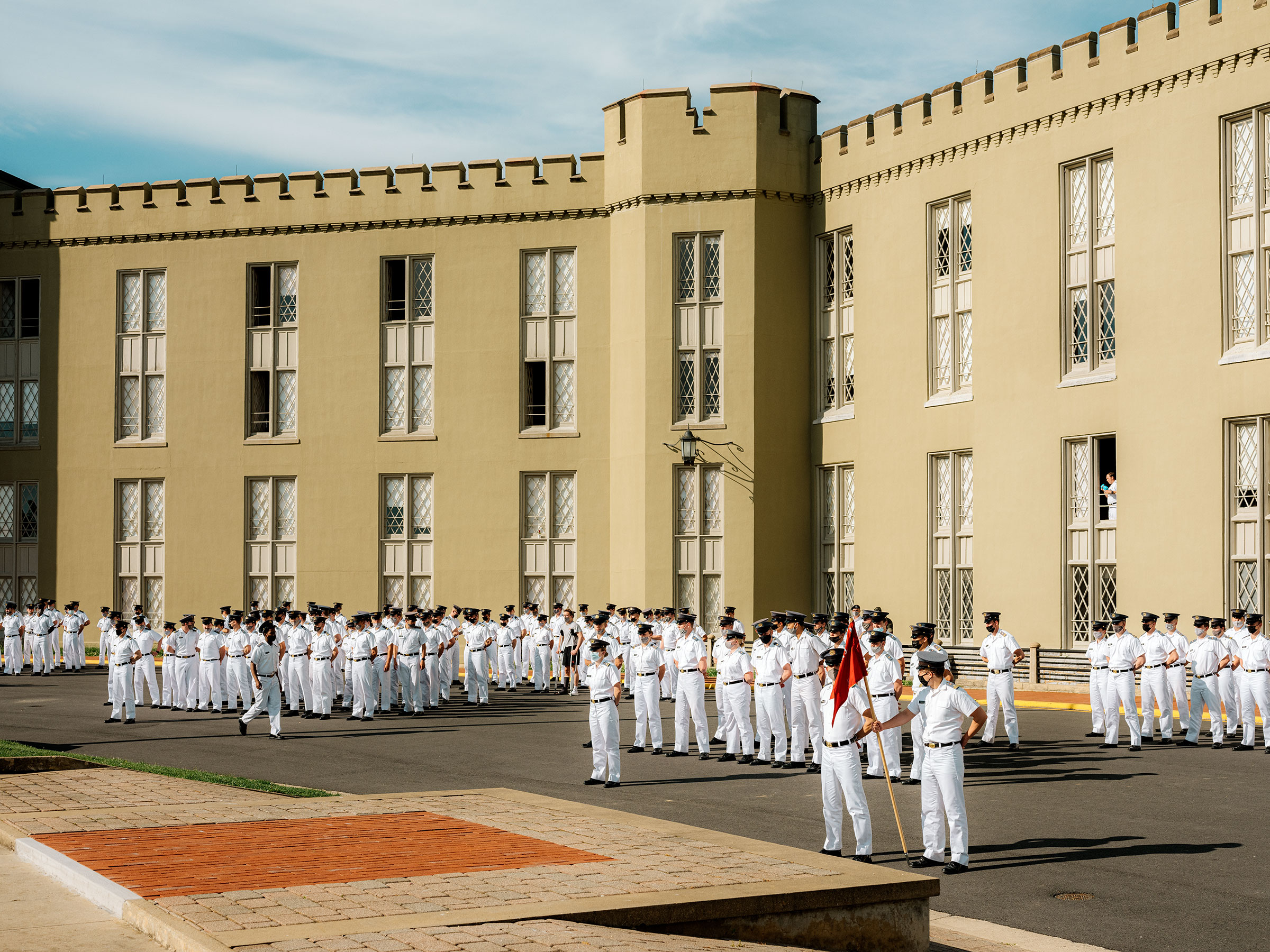
This April, on the 156th anniversary of Lee’s surrender at Appomattox, the members of VMI’s new Commemorations and Memorials Naming and Review Committee filed into an ornate room on campus, across the vast parade ground from the barracks. It was their first in-person meeting, and the first where they would consider the fate of Confederate symbols on post.
The school’s line these days is that reports of racism on campus are overblown, but that it is embracing change and welcomes the investigation, whose findings are set to be released on June 1. The committee had drawn up an inventory of 38 pieces of Confederate iconography, from the four Civil War cannons in front of the barracks to the gravestone marking the 1997 burial of the cremated remains of Jackson’s horse. Now it was time to decide what to do with them.
“Since we began this process last fall, we have invited comment from the entire VMI alumni community and the public, and we have gotten it in spades,” the committee’s chairman, Richard Hines V, began. “It runs the gamut from ‘pull out the eraser’ to ‘if you move anything, you are canceling the culture of VMI.’ ” An eloquent, bowtied trial lawyer whose first ancestor graduated from the institute in 1864, a century before he attended, Hines said the committee’s mission was to create “an inviting and a neutral landscape.”
A nuanced discussion of the interplay between past and present ensued. If Jackson was unfit to be honored with a statue, should his name also come off the arch behind it? Was there any way to “recontextualize” or move the 21-ft.-high painting of the New Market cadets charging into battle that greets visitors to Jackson Memorial Hall? Could the bronze statue of Virginia Mourning Her Dead be reoriented to honor all VMI’s war dead, not just those who fought at New Market?
S. Waite Rawls III, a 1970 VMI grad and former president of the Museum of the Confederacy, argued the displays were sending the wrong message. A first-time visitor would likely be confronted with the massive battle mural, with the result that “the first message they get is, VMI’s memorializing a bunch of damn Confederates,” he said. But he also cautioned the committee against “erasing” history, and wondered if they could find a new way to recognize Jackson’s military prowess, separate from the cause he fought for.
The threat of backlash hung over the discussion, as if the inertial force of collective nostalgia were itself a member of the committee. The alumni representative, Anthony Moore, a Black man, warned that donations could be imperiled. “If we go in and whitewash everything to do with the Confederacy, we’re going to lose a lot of support,” he said. “From the alumni perspective, the less we can change, the better.”
Midway through the meeting, Wins, the institute’s new superintendent, weighed in. A retired Army general with a quietly commanding air, Wins is regularly derided on alumni message boards as a Marxist and affirmative-action hire. In interviews, Wins told me that he didn’t personally experience racism at VMI but that he believes the Black cadets who have complained and is committed to changing the school’s atmosphere.
“In my time as a cadet, there was not a particular emphasis on Stonewall Jackson as a historical figure,” Wins said. Jackson graduated from West Point, he noted, yet there are no tributes to him there. When Wins himself was a rat, a white cadet quietly advised him he could direct his salute at the flag instead of the Jackson statue. “Everything we did, from saluting to walking through the arch, was about tradition,” Wins told the group. “I would ask, how much of this is about tradition, vs. history?”
Over nearly six hours, committee members both white and Black referenced the ways their perspectives had changed over time. Lester Johnson Jr., a Black member of the institute’s board, said he hadn’t paid much attention to things like statues when he was a cadet, but his eyes had been opened to their significance. “Now, with what I’m learning, I really struggle,” he said. “I just don’t understand the veneration.” For all the talk about the New Market cadets exemplifying valor and sacrifice, he said, as a Black man, he was never able to see them as anything but Confederate soldiers.
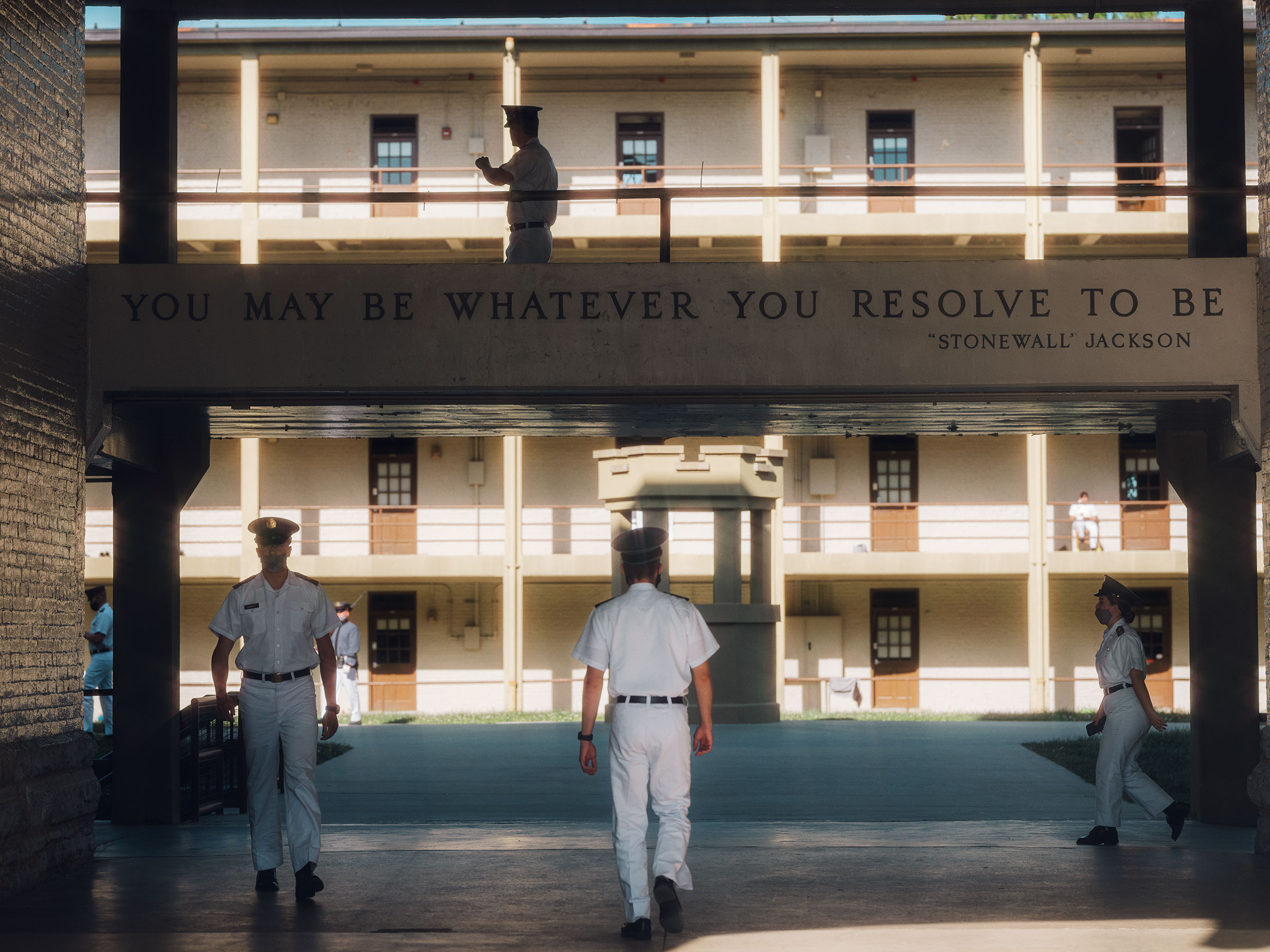
The awokening has been made up of millions of such tiny epiphanies: the history we weren’t taught, the horrors we weren’t meant to consider. In my conversations with dozens of VMI cadets, alumni, officials and parents, nearly every one described an evolving perspective on race in recent years. Like Shah Rahman, they’d formed their worldview and sallied confidently forth—until something came along to upend it. That is why the stakes of this fight are so high for all involved: myths like the Lost Cause can only survive if they are handed down from one generation to the next.
But progress is often divisive, and rarely comes without sacrifice. In 1965, a 26-year-old VMI graduate named Jonathan Daniels traveled to Alabama to join the cause of civil rights. A white New Hampshire native who was studying to be an Episcopal priest, Daniels had just been released from jail when he and two Black girls were confronted by a white man with a gun. The man pointed his shotgun at 17-year-old Ruby Sales. Daniels pushed her down, threw himself in front of the blast and was instantly killed.
The late Congressman and civil rights leader John Lewis later said it was Daniels’ selflessness that inspired him to activism. Martin Luther King Jr. called it “one of the most heroic Christian deeds of which I have heard in my entire ministry.” Daniels has been sainted and designated as a martyr by the Episcopal Church. At VMI, there is an award named for him, as well as a courtyard on the back side of the barracks. They are recent additions, and easy to miss, unlike the Confederate icons that immediately greet visitors.
At the committee meeting, members debated how better to honor Daniels, whose sacrifice they compared to that of the New Market cadets. Keith Gibson, VMI’s museum director, said he’d heard nothing about Daniels when he was a cadet in the 1970s. But recently, Gibson said, he had traveled to Alabama and retraced Daniels’ path, from the jail, to the concrete block that absorbed his blood, to his grave. Gibson was moved to tears as he recounted the experience of praying over the site where Daniels gave his life for the cause of racial equality.
Gibson has spent his entire career at the institute. He is the author of the school’s official history. Alums from the 1990s recall him roaming campus in a Confederate uniform (though Gibson denies this) and presiding over the burial of Jackson’s horse. But as he talked about Daniels’ legacy, he sounded positively, well, woke. Stokely Carmichael, who was in jail with Daniels, tried to warn the young seminarian, but Daniels was undeterred, Gibson told the committee. Like a soldier going into battle, he may not have known he would be killed, but he knew he was putting himself in danger.
The old white man’s voice shook with emotion. “There’s the heroism. There’s the courage,” Gibson said. “The work is still under way that Jonathan Daniels was involved in, and it falls to us.” We are all on a journey, each at his own pace.
— With reporting by Leslie Dickstein, Madeline Roache, and Simmone Shah.
Correction, June 1: The original version of this story misstated Keith Gibson’s attire at the 1997 burial of the cremated remains of Stonewall Jackson’s horse. He was wearing a suit and tie, not Confederate battle dress.
- Dua Lipa Manifested All of This
- Exclusive: Google Workers Revolt Over $1.2 Billion Contract With Israel
- Stop Looking for Your Forever Home
- The Sympathizer Counters 50 Years of Hollywood Vietnam War Narratives
- The Bliss of Seeing the Eclipse From Cleveland
- Hormonal Birth Control Doesn’t Deserve Its Bad Reputation
- The Best TV Shows to Watch on Peacock
- Want Weekly Recs on What to Watch, Read, and More? Sign Up for Worth Your Time
